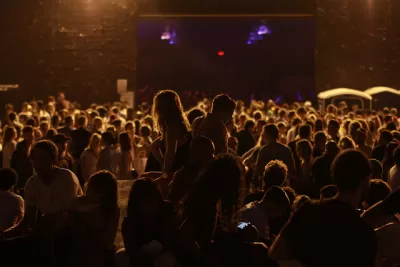Guess which group is losing faith in the American Dream? Washington Post Wonkblog reporters Jim Tankersley and Scott Clement write on a Fusion 2016 Issues Poll released December 1 that surveys millennials on their chances for upward mobility.

"(Y)oung workers today are significantly more pessimistic about the possibility of success in America than their counterparts were in 1986, according to a new Fusion 2016 Issues poll reported in conjunction with The Washington Post," write Jim Tankersley and Scott Clement.
That rise in pessimism among millennials is concentrated among white people. It is most pronounced among whites who did not earn a college degree.
The comparison to 1986 comes "from a Roper/Wall Street Journal poll of young Americans" conducted that year. The Fusion poll replicates it so as to compare attitudes of today's millennials with the same age group 29 years ago. Unlike whites, "(t)he poll found no statistically significant change among young Americans of color over the decades," note Tankersley and Clement.
In 1986, they were about twice as likely as whites to say the American Dream does not exist. Now, the groups are about equally pessimistic.
As has been reported here, "(m)illennials in general define the dream differently than Generation Xers did in the 80s," write the reporters.
Today's young people are less likely to say owning a home or having "freedom of choice in how to live one's life" and the ability to become wealthy are part of the American Dream. They are more likely to say that starting a business was part of the dream; [ ...] that item topped millennials' list of possible American Dream components.
"And one of the big components of the American dream—the pursuit of wealth—is also losing ground among young people," writes Fusion's Katie McDonough. "Becoming wealthy ranked dead last—listed by just 29% of young people as very much part of the American Dream, down from 40% in 1986."
Click on the graphics showing the top three goals of young people in 1986 and today.
FULL STORY: Young white people are losing their faith in the American Dream

Maui's Vacation Rental Debate Turns Ugly
Verbal attacks, misinformation campaigns and fistfights plague a high-stakes debate to convert thousands of vacation rentals into long-term housing.

Planetizen Federal Action Tracker
A weekly monitor of how Trump’s orders and actions are impacting planners and planning in America.

San Francisco Suspends Traffic Calming Amidst Record Deaths
Citing “a challenging fiscal landscape,” the city will cease the program on the heels of 42 traffic deaths, including 24 pedestrians.

Defunct Pittsburgh Power Plant to Become Residential Tower
A decommissioned steam heat plant will be redeveloped into almost 100 affordable housing units.

Trump Prompts Restructuring of Transportation Research Board in “Unprecedented Overreach”
The TRB has eliminated more than half of its committees including those focused on climate, equity, and cities.

Amtrak Rolls Out New Orleans to Alabama “Mardi Gras” Train
The new service will operate morning and evening departures between Mobile and New Orleans.
Urban Design for Planners 1: Software Tools
This six-course series explores essential urban design concepts using open source software and equips planners with the tools they need to participate fully in the urban design process.
Planning for Universal Design
Learn the tools for implementing Universal Design in planning regulations.
Heyer Gruel & Associates PA
JM Goldson LLC
Custer County Colorado
City of Camden Redevelopment Agency
City of Astoria
Transportation Research & Education Center (TREC) at Portland State University
Jefferson Parish Government
Camden Redevelopment Agency
City of Claremont




























